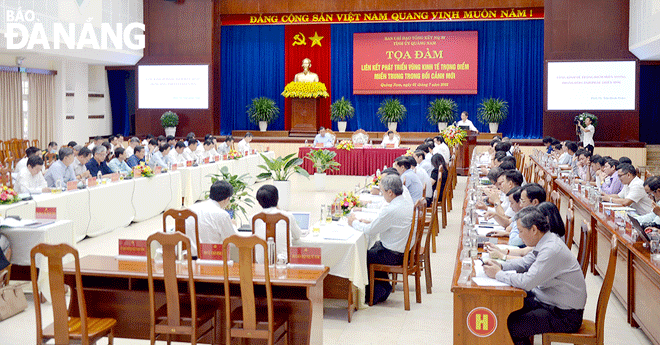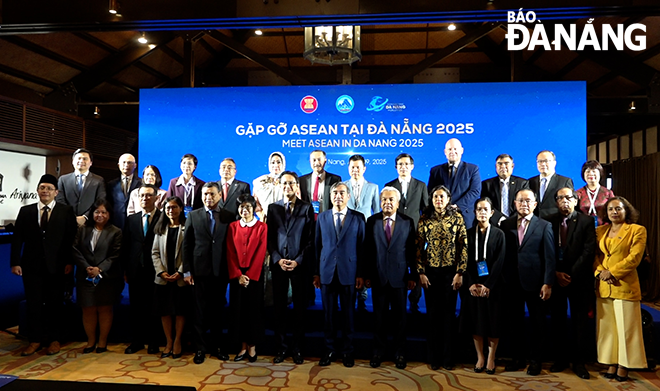Solutions needed to awaken potential of central key economic zone
The Central Key Economic Zone is making strong development steps, thereby significantly contributing to driving the development of the country. However, it is necessary for the zone to soon take effective solutions to overcome its current shortcomings and develop in the right direction in a bid to become a driving force in both the North Central and Central Coast regions and the whole country.
 |
| A scene of the scientific seminar on promoting linkages for the development of the central key economic zone in the new context held in July in Quang Nam Province |
The zone’s development is not commensurate with its potential
In his remarks at the scientific seminar on promoting linkages for the development of the central key economic zone in the new context held in July in Quang Nam Province, Chairman of the Party Central Committee’s Economic Commission Tran Tuan Anh said that, in general, despite maintaining a high growth rate for a long time, the economic scale of the central key economic zone was still relatively small and accounted for a relatively low proportion of the country’s economy.
In addition, the zone’s per capita income is still low compared to the national average’s. The agricultural development is not sustainable, and the restructuring is slow and unclear. Although some localities have large budget revenues, they still rely heavily on a number of local large-scale enterprises.
During the seminar, leaders of the five localities in the zone pointed out some difficulties facing the zone over the past time. Especially, the Central Key Economic Zone Council has operated ineffectively.
In his speech at the event, Da Nang Party Committee Secretary Nguyen Van Quang stressed the need to boost the connection between coastal and central highland localities in order to promote the development of the zone because the Central region is the gateway to the sea of the Central Highlands, connecting the East West Economic Corridor.
Orientations and solutions for the development of the zone
Speaking at a meeting in mid-August to review the implementation of the Politburo-adopted Resolution No 39 dated August 16, 2004 and Conclusion No. 25-KL/TW dated August 2, 2012, Secretary Nguyen Van Quang proposed the Politburo to issue a new resolution on socio-economic development and assurance of national defence and security in the North Central and Central Coast regions by 2030, with a vision to 2045.
He added the focus should be on considering the division of the zone in a more reasonable manner, as well as integrating the development orientations of localities that have their own development resolutions into a new regional resolution, in order to form local clusters and groups with geographical characteristics, potential linkages and advantages that can support each other.
He also underlined a must-do for the government to perfect institutions of the Coordinating Council of the North Central and Central Coast regions, including the central key economic zone, in a bid to promptly participate in the process of developing and implementing regional planning.
Importance should be attached to studying, reviewing and supplementing the functions and tasks of the zone’s Coordinating Council, thereby contributing to solving the shortcomings over the past time, and improving the effectiveness and efficiency in regional coordination and development.
Da Nang Party chief Quang also suggested that the five localities in the zone should actively cooperate and agree on guidelines, funding and specific focal points to develop annual coordination solutions, create a unified economic space, and limit ineffective competition among localities.
Assoc. Prof. Dr. Tran Dinh Thien, former Director of the Viet Nam Institute of Economics, Chairman of the Scientific Council of the Viet Nam Institute of Economics, understood the necessity to make a development plan for the zone, with priority given to exploiting the zone’s advantages of seaports, airports, tourism resources and large-scale projects, and preventing the risk of wasting resources and damaging the development process as well.
Sharing the same opinion, Dr. Tran Du Lich, a member of the National Advisory Council for Monetary Policies, underlined the necessity to urgently develop a master plan for the development of the North Central and South Central Coast regions for the 2021-2030 period, as well as perfect the linkage and coordination mechanism for regional development.
He emphasised drastic solutions are in need to solve 4 existing problems about planning the distribution of economic sectors and development fields and areas, joint construction of common infrastructure (especially traffic), environmental protection, and the development of human resources and general labor market in order to promote the development of the zone effectively.
Reporting by TRIEU TUNG - Translating by M.DUNG








